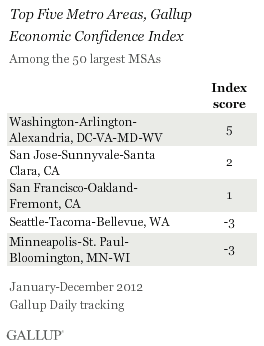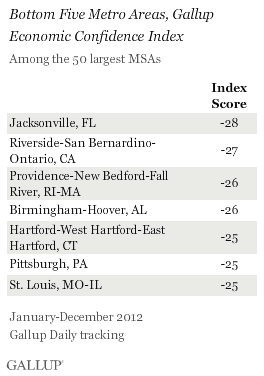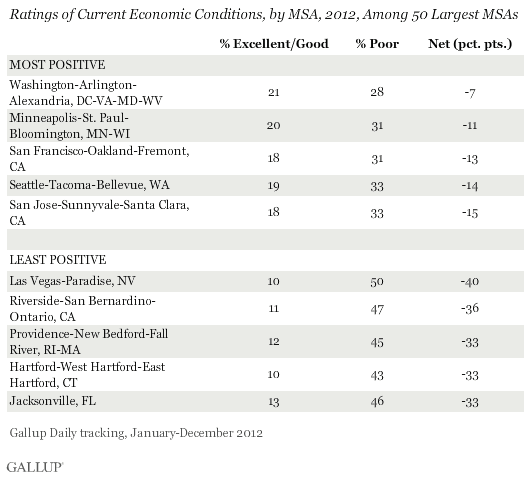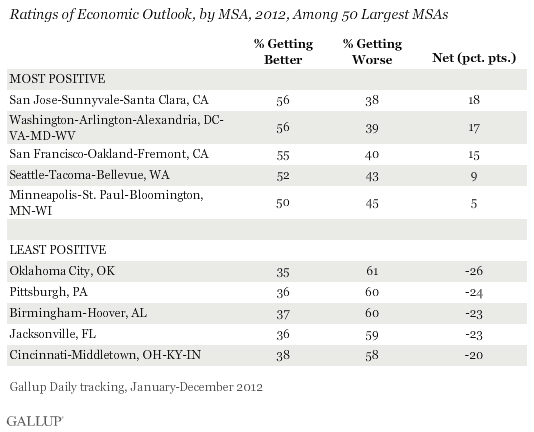WASHINGTON, D.C. -- Residents of the Washington, D.C., metropolitan area expressed the most confidence in the U.S. economy among the largest 50 metro areas in 2012, as they did in 2011. The D.C. metro area had a Gallup Economic Confidence Index score of 5 in 2012, up from -20 in 2011. Three of the 50 largest metro areas had positive scores on the Gallup Economic Index last year, while none had positive scores in 2011. Residents of Jacksonville, Fla., had the lowest economic confidence of this group in 2012, with a score of -28, followed closely by residents of Riverside, Calif.


The results are based on more than 82,000 Gallup Daily tracking interviews conducted throughout 2012 in the 50 most populous U.S. Metropolitan Statistical Areas (MSAs). Gallup interviewed between 537 and 7,161 respondents per MSA, with more than 1,000 respondents in 30 of the MSAs. Each MSA sample is weighted to match the demographic characteristics of that area. The full 2012 data for all MSAs can be found on page 2.
Gallup's Economic Confidence Index is based on the combined responses to two questions: the first asks Americans to rate economic conditions in this country today, and the second asks whether they think economic conditions in the country as a whole are getting better or getting worse. The highest possible score on the index is +100 and the lowest is -100. While the questions specifically ask respondents to rate the national rather than the local economy, clearly the health of a person's local economy will influence how he or she thinks about the larger national economy.
Washington, Minneapolis, and San Jose, Calif., each maintained its spot in the top five metro areas for economic confidence in 2012. The high level of economic confidence in the nation's capital may be due to the overall stability of federal government jobs. Residents in San Jose and San Francisco may have high economic confidence as a result of the booming technology industry in Silicon Valley.
Jacksonville and Riverside ranked in the bottom five in 2012 and 2011, although their economic confidence scores improved this year. These two are also among the metro areas with the lowest Job Creation Index scores, which may contribute to their lower levels of economic confidence.
Nationwide, the Gallup Economic Confidence Index averaged -21 in 2012. Thirty-seven of the largest metro areas scored above the national average of -21 and 11 metro areas scored below it, indicating that Americans living in the largest cities and their suburbs are generally more positive about the economy than those living in less populated areas.
Washington Most Upbeat About Current Economy; Las Vegas Most Pessimistic
Washington metro area residents were the most positive about current economic conditions last year compared with residents of other large metro areas, which also was the case in 2011, when D.C. was tied with San Antonio. Still, residents of the Washington metro area were slightly more likely to rate current conditions as "poor" than as "excellent" or "good." The metro areas with the five most upbeat ratings of the current economy were all in the top five metro areas on the overall Economic Confidence Index.
Las Vegas-area residents had the most negative ratings of current economic conditions -- as they did last year -- followed by those living in the Riverside; Providence, R.I.; Hartford, Conn.; and Jacksonville areas.

San Jose residents had the most positive economic outlook, with 56% saying the economy was getting better and 38% saying it was getting worse, for a net economic outlook score of 18. The metro areas that ranked in the top five on the Economic Confidence Index all had positive 2012 net economic outlook scores. In 2011, no metro area had a positive economic outlook score.
Residents of the Oklahoma City area were the most pessimistic about the economy's direction, with 35% saying it was getting worse and 61% better, for a net score of -26. Those living in Pittsburgh, Birmingham, Ala., Jacksonville, and Cincinnati also were quite pessimistic about the nation's economic future.

Bottom Line
Overall, economic confidence scores in large metro areas were more positive last year than in 2011. Residents in the Washington, San Jose, and San Francisco areas had the most positive scores on the Gallup Economic Confidence Index.
Nationally, the Economic Confidence Index has remained in negative territory since Gallup began daily tracking in 2008. But Americans' economic confidence has improved so far in 2013, matching a five-year monthly high in January and February. These signs suggest Americans are feeling more confident about their local job market and the U.S economy.
Gallup.com reports results from these indexes in daily, weekly, and monthly averages and in Gallup.com stories. Complete trend data are always available to view and export in the following charts:
Daily: Employment, Economic Confidence, Job Creation, Consumer Spending
Weekly: Employment, Economic Confidence, Job Creation, Consumer Spending
Read more about Gallup's economic measures.
View our economic release schedule.
Survey Methods
Results are based on telephone interviews conducted as part of Gallup Daily tracking Jan. 1-Dec. 31, 2012, with random samples of adults, aged 18 and older, living in the 50 largest Metropolitan Statistical Areas by population.
Margins of error for individual MSAs are no greater than ±5 percentage points, and are ±3 percentage points in most MSAs.
Interviews are conducted with respondents on landline telephones and cellular phones, with interviews conducted in Spanish for respondents who are primarily Spanish-speaking. Each sample includes a minimum quota of 400 cellphone respondents and 600 landline respondents per 1,000 national adults, with additional minimum quotas among landline respondents by region. Landline telephone numbers are chosen at random among listed telephone numbers. Cellphone numbers are selected using random-digit-dial methods. Landline respondents are chosen at random within each household on the basis of which member had the most recent birthday.
Samples are weighted by gender, age, race, Hispanic ethnicity, education, region, adults in the household, and phone status (cellphone only/landline only/both, cellphone mostly, and having an unlisted landline number). Demographic weighting targets are based on the March 2011 Current Population Survey figures for the aged 18 and older non-institutionalized population living in U.S. telephone households. All reported margins of sampling error include the computed design effects for weighting.
In addition to sampling error, question wording and practical difficulties in conducting surveys can introduce error or bias into the findings of public opinion polls.
For more details on Gallup's polling methodology, visit www.gallup.com.

